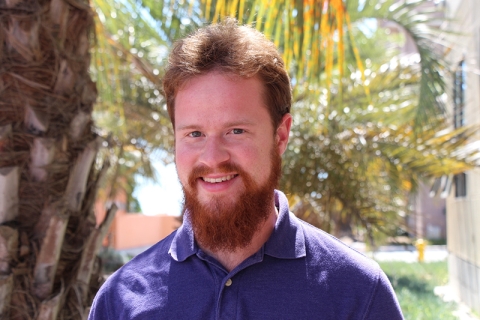
Date:
Location:
Speaker:
Title: Engineering flavin-based fluorescent proteins for oxygen-independent biosensing applications
Abstract
Flavin-based fluorescent proteins (FbFPs) are small, oxygen independent fluorescent proteins derived from naturally occurring phototropins, which fluoresce in the green range. FbFPs have the potential to fill a critical gap in bioimaging of anaerobic and hypoxic biological systems. This gap exists because the green fluorescent protein (GFP) and its derivatives require an oxygen-dependent post-translational modification to cyclize three residues to form the active chromophore. As FbFPs bind flavin, a universally available vitamin in all organisms, as their chromophore, they do not require oxygen to become fluorescent. However, FbFPs do suffer from several weaknesses, including significantly lower brightness than GFP, lack of a varied color palette, and a relative lack of biosensors based on FbFPs. Within, we present engineering efforts toward making FbFPs highly useful bioimaging tools, particularly for use in anaerobic contexts.
One obstacle to engineering FbFPs has been a lack of understanding of flavin-binding dynamics. As flavins are universally available in cells, and flavin-auxotrophic cell lines require flavin supplementation for survival, obtaining an FbFP not bound to flavin has proven difficult. Here we focus on the FbFPs iLOV and EcFbFP. Unsupported denaturation and buffer exchange of FbFPs has resulted in insoluble, misfolded protein which cannot be reconstituted with flavin. We have devised a protocol by which His-tagged FbFPs are bound to a nickel support, then denatured, buffer exchanged, and refolded, thus yielding properly folded flavin-free protein. We demonstrate that fluorescence can be recovered by adding flavin back to the protein. Through flavin titration, we have determined dissociation constants between both iLOV and EcFbFP, and three naturally occurring flavin cofactors: riboflavin, flavin mononucleotide (FMN), and flavin adenine dinucleotide (FAD). This has shown that FbFPs bind flavins with affinities in the hundreds of nanomolar range, with greatest affinity for FAD and FMN, binding less tightly to riboflavin. Further, we show that deflavinated FbFPs can be used as an effective in vitro sensor for flavin. Understanding of the critical flavin binding dynamics of FbFPs should enable further efforts in engineering the protein-cofactor interaction and help enable incorporation of non-native cofactors into FbFPs.
In order to enable more extensive biosensor construction from FbFPs, we sought to create the first circular permutation of an FbFP. Circular permutation has enabled construction of numerous biosensors from GFP by placing new termini in close proximity, so that fluorescence can be modulated by fused metabolite binding domains. Leveraging structural data and systematic domain insertion, we have determined that iLOV can be circularly permuted about residues G95 and E96, while fusing the original termini with a native phototropin helix and an engineered linker; yielding a dim but fluorescent protein. We then demonstrate that fluorescence can be recovered to approximately the level of linear iLOV by fusing dimerizing coiled-coil leucine zipper domains to the new termini. Using this “zipped” circularly permuted iLOV, we created fluorescent sensors for the activity of two proteases; tobacco etch virus protease and SARS-CoV-2 main protease. These sensors show a 73 and 61% decrease in fluorescence, respectively, upon expression of the appropriate protease. We expect that our creation of a circularly permuted iLOV will enable building a wide variety of FbFP-based biosensors, much in the same way that circular permutation of GFP has enabled building of a wide variety of GFP-based biosensors.



